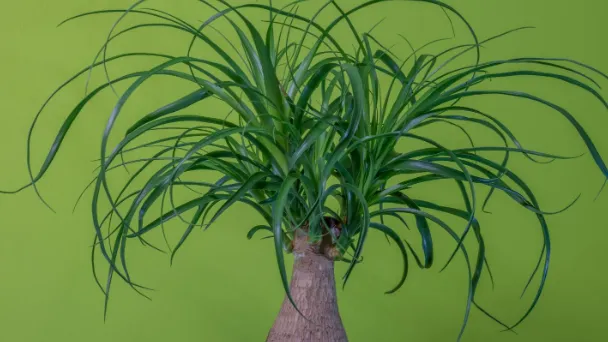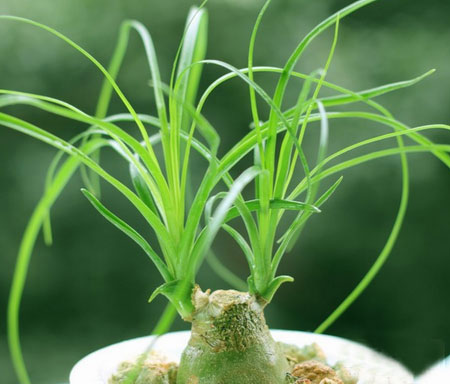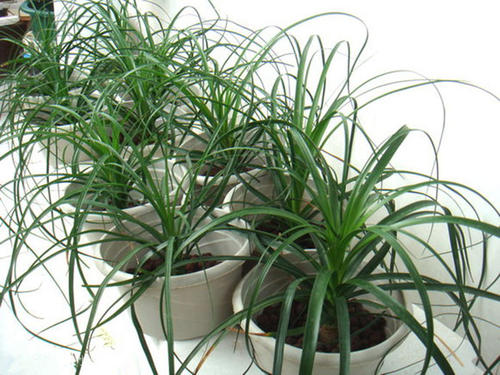How to Grow and Care for Ponytail Palm (Beaucarnea Recurvata)
Written by Maggie
Feb 02 2023

Ponytail Palm (Beaucarnea Recurvata) is a very common foliage plant, and many people choose to grow it at home to decorate the environment. Because the stem shape is peculiar, base special bangs are big, resemble magnum bottles, add the bark that crackles into a small cube and tufted leaf appearance to dance again, Ponytail palm becomes a very peculiar adornment plant. Placing the plant somewhere bright will benefit it because ponytail palms prefer to have as much light as possible. How to grow and care for Ponytail Palm? Let's look down together.
Ponytail Palm Quick Info
| Botanical/Scientific Name | Beaucarnea Recurvata |
| Common Name | Ponytail Palm |
| When to Grow/Bloom/Harvest | Spring is the traditional planting time |
| Uses | Absorbs common toxic gasses |
| Origin | Southeastern Mexico |
| Light Care | Bright indirect light to full sun |
| Soil Care | Fairly dry |
| Temperature Care | Ideal temperatures above 45°F (7°C) at night |
| Humidity Care | Average |
| Watering | Water when the soil is completely dry |
| Pruning Care | Pruning during growing season of spring through early fall |
| Fertilizer Care | Fertilized once or twice per month |
| Propagation | Cuttings and Seeds |
| Toxic | Non-toxic to cats, dogs, and horses |
| Flower Color | White, Yellow |
When to Plant Ponytail Palm
Ponytail palm likes light, and its warm and humid climate is also its favorite. In spring and autumn, the temperature is neither too high nor too low. It's just right. It's very suitable for the newly transplanted ponytail palm to recover effectively and better adapt to the new environment.Ponytail Palm Care in Detail
Soil Requirements
Ordinary soil has low sand content, low water permeability, low water retention quality and less air permeability than sandy soil. Therefore, the sandy soil is the most suitable for ponytail palm. Although the quality of ponytail palm for soil is not high, cultivating it in high-quality sandy soil can prolong its life and make it grow better.Humidity
Humidity is very important for ponytail palm. Because ponytail palm likes to live in humid soil, the growth rate of palm trees will be much slower in winter. At this time, water can be poured once every 10 days. But in hot summer, we can water 4-6 times a week. Due to the high temperature, we need to increase the frequency of watering, even once a day. But observe the drainage phenomenon. In any case, pay attention to the watering amount to avoid improper drainage, which will rot the ponytail palm. Potted ponytail palm can be watered once a week. (Read More: How Big Do Ponytail Palms Get)Pruning
On the one hand, ponytail palm pruning is for ornamental beauty. On the other hand, proper pruning of branches and leaves can regulate the growth of trees, reduce the occurrence of diseases and pests and ensure their healthy and rapid growth. Ponytail palm pruning time generally has two periods, one is winter pruning, the other is summer pruning. Winter pruning is to grow fruiting branches in the coming year, and summer pruning is to prune bare branches. Ponytail palm pruning should cooperate with fertilization. (Read More: How To Prune A Ponytail Palm Plant)Repotting
Before ponytail palm repotting, we can reverse the basin soil, take out the plant with soil, and remove some old soil, old roots and dead roots around the soil lump; Then put some new culture soil on the bottom of the basin, and the thickness shall be subject to the height of the plant; We can put the soil lump of ponytail palm plant back into the flower pot, fill it with new culture soil around and compact it slightly. After filling, some sustainable soil fertilizers can be applied, and water shall be poured once. (Read More: How to Repot Ponytail Palm)The size of the flowerpot used by ponytail palm repotting is 1 ~ 2 times that of the original flowerpot, because the younger plants do not grow faster in large flowerpots. In fact, the plant began to grow only after the plant roots were completely woven in the basin soil. In view of this, the pot change time of ponytail palm should be after the root system has fully grown in the original pot, that is, in actual operation, it is allowed to change the pot only after the root system is found in the gap of the pot.
In ponytail palm repotting, we can usually determine the depth of the soil lump at the root of the plant, then fill the required culture soil at the bottom of the new pot, put the plant soil lump on it, and finally fill the culture soil around the flower pot and compact it. Another way to change the pot is to start from the center of the bottom of the plant soil lump to the surrounding, grab the soil with both hands and remove the root soil to expose the root system, and then plant it in the new culture soil for changing the pot. This method is more practical in some cases, especially when transplanting in a flower pot with low and wide perimeter. If the soil lump of the plant is not large, some sustainable fertilizers should be applied on the surface of the new culture soil.
Light & Temperature
Ponytail palm likes to grow in a sunny place, so it cannot be conserved in a cool place. When caring for Ponytail Palm in the growing season, it needs more than 6 hours of sunlight. However, in summer, it needs to shade the Ponytail palm appropriately. Plant growth temperature should be near 25℃, and do a good job of cooling treatment in summer, winter needs to be moved to indoor maintenance.
Watering
There is no need to water the plant every day. Ponytail Palm is suitable for growing in dry and clean soil, and the principle of not watering the soil is done. In summer, the water demand is large, so it can be watered once every three days. In winter, it depends on the soil condition and do not let the soil water
Read More:
- Overwatered Ponytail Palm - Signs & Solutions
- How to Save Your Underwatered Ponytail Palm
- Is Ponytail Palm Toxic To Cats
Fertilizer
In the peak growth season of Ponytail palm, nitrogen and phosphorus fertilizers are needed. It is best to apply fertilizer once every 16 days, and the fertilizer should not be directly drenching on the leaves. Easily absorbable farm manure should be used in summer to reduce the damage to the root system. Fertilization should be stopped in winter.
Diseases & Pests Care
Ponytail palm is susceptible to disease and insect disease, which can cause the leaves to shrift and tear off within a week. When a large area of leaf wilt occurs, the plant needs to be sprayed with 300 times diluted Bordeaux and the planting soil should be changed.
Read More:
- How to Take Care of Ponytail Palm Rot Root
- Ponytail Palm Leaves Drying & Bulb Softening Causes & Care Solutions

Ponytail palm is one of the best trees for pots
Ponytail Palm Care for Roots Rot
The rotting roots of Ponytail palm depend on whether the situation is serious or not. If the rotting roots are only slightly rotted, they will recover after a period of good curing. If the rotting roots are serious, they need to be removed from the pot, cut off the rotting roots, and then disinfect and dry the wounds. The following are Beaucarnea Recurvata care tips for roots rot.
Sir Dry Basin Soil
What if over-watering causes rot of Ponytail palm roots? This situation is generally not too serious, as long as the pot soil can be dried. First use tools to turn the pot soil, and then put it in a well-ventilated place for maintenance, so that the pot soil can be dried quickly.
Wash the Basin Soil
If improper fertilization or heavy fertilizer leads to mild root rot of Ponytail palm, it can be watered a lot. When we grow and care for Ponytail Palm, the excessive fertilizer in the pot soil should be flushed out to dilute the fertilizer in the soil, and then the water in the pot soil should be discharged in time and preserved in a cool place. No watering and fertilizer can be applied in a short time.
- Read More: How Often to Water Your Ponytail Palm
Cut off Rotten Roots
If the root of the Ponytail palm is seriously ulcered, it is necessary to take off the pot in time, cut off the rotten roots, and then disinfect the wound after cutting. When caring for Ponytail Palm, plant ash or Peliomycete solution can be used to smear the wound, which can make the wound heal quickly and prevent secondary infection.
Replace the Basin Soil
There is no need to change the soil. Changing the soil is only because the pot soil breeds bacteria that infect the roots. If the soil is not changed, even if the rotting roots are cut off, the Ponytail palm will still get infected again, so it needs to change the soil and replant.

Ponytail Palm - Most Common House Plant & one of the best indoor trees
Ponytail Palm Propagation
Propagating Ponytail Palm from Cutting
The ponytail palm propagation we first thought of is cutting, but there are also some preconditions for cutting. If the ambient temperature of ponytail palm propagation from cutting is very low, it will affect the survival rate of ponytail palm and reduce the survival rate of ponytail palm. The optimal propagation temperature of asparagus is 20-30 degrees, For asparagus to be used for cutting, select some bamboo with more leaves, mark a small hole on the bamboo, then coat it with mosses, and place it in a ventilated place for about ten days. In this environment, keep the humidity of ponytail palm appropriate. Put some soft and moist soil into a cloth bag, then tie some small holes outside the cloth bag, insert the cuttings from the small holes, and then put them in the basin to fill with sand and soil. Don't cover them too tightly.
How to Propagate Ponytail Palm from Seed
Ponytail palm propagation from seed first, we have to wait until the seed becomes soft, which means it is mature. Then we can pick the seed, wash it with water, dry it after washing, and then store it. In April, we plant the seed in sand, and then use wooden pots, Put three seeds in each basin, cover the sand and soil, water it a lot, and then seal it with plastic wrap. The next environment should maintain a temperature of more than 25 degrees and the soil should be wet enough.
Read More: How to Propagate Ponytail Palm (Steps from Seeds & Cuttings)
Ponytail Palm Benefits
Ponytail palm has a strong astringent effect. It has a very good therapeutic effect on all kinds of hemoptysis and bleeding symptoms. It can effectively stop bleeding and cool blood.
Ponytail palm covers all parts of the motherland and is widely distributed, so the difficulty and cost of planting are relatively low compared with other plants, and it can decorate gardens and parks. So as to highlight a certain ornamental value. Because it is evergreen all year round, it is very popular with people. Ponytail palm can be viewed for a long time, because as a leaf viewing plant decoration, the whole home environment or our city has brought green vitality to people.
Ponytail palm represents hope and peace. Ponytail palm is tall and beautiful and can resist a variety of toxic gases. Brown bark is widely used, so it is an ideal tree species for garden combined production and an excellent tree species for factory greening. It can be planted in rows, clusters or in pieces. Ponytail palm also uses potted or barrel plants for indoor or building front decoration and venue layout. (Read More: Why Does My Ponytail Palm Have Brown Tips)
Latest Updated
- How to Grow and Care for Ponytail Palm (Beaucarnea Recurvata)
- How Much Light Does Ponytail Palm Need Indoors?
- Overwatered Ponytail Palm - Signs & How to Save It
- How to Save Your Underwatered Ponytail Palm
- How To Prune A Ponytail Palm Plant with Simple Steps
- How Can I Make My Ponytail Palms Grow Taller & Faster?
- How to Repot Ponytail Palm - A Guide To Transplant
- How Often to Water Your Ponytail Palm?
- How Big Do Ponytail Palms Get - Does It Need Deep Pots
- Is Ponytail Palm Toxic To Cats - Explained & Facts
Popular Articles
- Winter maintenance of Antirrhinum Majus
- How to Grow Terminalia Mantaly Tree
- How to Grow and Care for Crossostephium Chinense
- How to grow Antirrhinum Majus in spring
- Peristeria Elata (Dove Orchid) Profile: Info & Care Guide
- Underwatered Snake Plant (Sansevieria Trifasciata) - Signs And How To Fix
- How to Care for Brazilian Jasmine Plant (Mandevilla Sanderi)
- Rosa Chinensis (China Rose): Plant Growing & Care Tips
- How to Grow & Care for Graptopetalum Purple Delight in Summer
- How to Care for Baby Sun Rose (Aptenia Cordifolia)